Thoroughly analyzing TS Inter 2nd Year Physics Model Papers and TS Inter 2nd Year Physics Question Paper March 2018 helps students identify their strengths and weaknesses.
TS Inter 2nd Year Physics Question Paper March 2018
Time: 3 Hours
Maximum Marks: 60
Section – A (10 × 2 = 20)
Note :
- Answer all questions.
- Each question carries two marks.
- All are Very Short Answer Type Questions.
Question 1.
What is hypermetropia ? How can it be corrected ?
Answer:
Hypermetropia (or) Farsightedness: The light from a distant object arriving at the eye – lens may get converged at a point behind the retina. This type of defect is called Hypermetropia.
To correct this, we interpose a convex lens (Convergent lens) between the eye and the object.
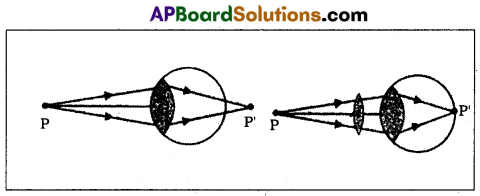
Question 2.
How do you convert a moving coil galvanometer into an ammeter ?
Answer:
A small resistance is connected in parallel to the moving coil galvanometer, then it converts to Ammeter.

Question 3.
What is the magnetic moment associated with a solenoid ?
Answer:
Magnetic moment of a solenoid (M) = n × 2l × πa2
Where n = Total number of turns
2l = Length of the solenoid
i = Current
πa2 = Crossesectional area.
Question 4.
Define magnetic declination.
Answer:
Magnetic Declination (D) : The angle between the true geographic north and the north shown by a compass needle is called magnetic declination or simply declination (D).
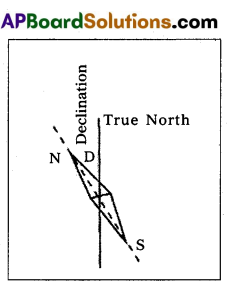
Question 5.
Write the expression for the reactance of an inductor and a capacitor.
Answer:
Inductive reactance (XL) = ωL.
Capacitive reactance (XC) = \(\frac{1}{w c}\).
![]()
Question 6.
What are the applications of microwaves ?
Answer:
- Microwaves are used in Radars.
- Microwaves are used for cooking purposes.
Question 7.
Write DeBroglie’s relation and explain the terms therein.
Answer:
The de-Broglie wave length (λ) associated with a moving particle is related to its momentum (p) is X where particle is related to its momentum (p) is λ = \(\frac{\mathrm{h}}{\mathrm{p}}=\frac{\mathrm{h}}{\mathrm{mv}}\) where h is plank’s constant.
Question 8.
What is work function ?
Answer:
The minimum energy required to liberate an electron from photometal surface is called work function, Φ0.
Question 9.
Draw the circuit symbols for p-n-p, & n-p-n transistors.
Answer:
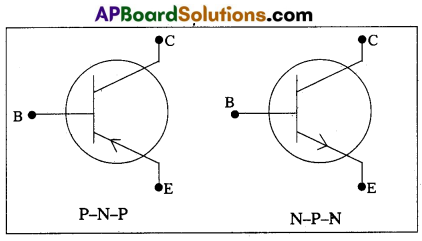
Question 10.
Mention the basic methods of modulation.
Answer:
The basic methods of modulation are :
- Amplitude modulation (AM)
- Frequency modulation (FM)
- Phase modulation (PM)
Section – B (6 × 4 = 24)
Note :
- Answer any six of the following questions.
- Each question carries four marks.
- All are Short Answer Type Questions.
Question 11.
Define critical angle. Explain total internal reflection using a neat diagram.
Answer:
Critical angle: When light ray travelling from denser medium to rarer medium, then the angle of incidence for which angle of refraction in air is 90° is called critical angle.
C = sin-1\(\frac{1}{\mu}\)
Total internal reflection: When a light ray travels from denser to rarer medium, the angle of incidence is greater than the critical angle, then it reflects into the same medium is called total internal reflection.
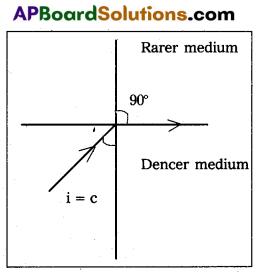
Explanation : Consider an object in the denser medium. A ray OA incident on XY bends away from the normal. As the angle of incidence is increased, the angle of refraction goes on increasing. For certain angle of. incidence, the refracted ray parallel to XY surface (r = 90°).
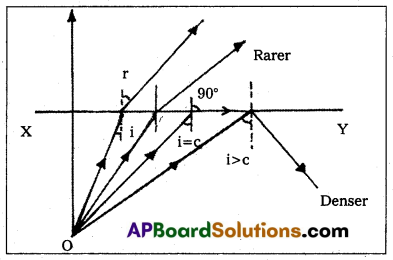
When the angle of incidence is further increased, the ray is not refracted but is totally reflected back in the denser medium. This phenomenon is called total internal reflection.
Question 12.
How do you determine the resolving power of your eye ?
Answer:
Make black strips of equal width separated by white strips. All the black strips having same width, while the width of white strips should increase from left to right.
Now watch the pattern with one eye. By moving away (or) closer to the wall, find the position where you can just see some two black strips as separate strips.
All black strips to the left of this strips would merge into one another and would not be distinguishable on the other hand, the black strips to the right of this would be more and more clearly visible.
Note the width d of the white strips and measure the distance D of the wall from eye.
The resolution of your eye = \(\frac{\mathrm{d}}{\mathrm{D}}\).
![]()
Question 13.
State Gauss’s law in electrostatics and explain its importance.
Answer:
Gauss’s law: The total electric flux through any closed surface is equal to \(\frac{1}{\varepsilon_0}\) times the net charge enclosed by the surface.
Total electric flux, Φ = \(\int_s \vec{E} \cdot d \vec{s}=\frac{q}{\varepsilon_0}\)
Here q is the total charge enclosed by the surface ‘S’, ∫ represents surface integral of the closed surface.
Importance :
1) Gauss’s law is very useful in calculating the electric field in case of problems where it is possible to construct a closed surface. Such surface is called Gaussian surface.
Question 14.
Derive an expression for the capacitance Of a parallel plate capacitor.
Answer:
Consider two parallel plates A and B separated by a distance d in air. The upper plate A is given a charge +q and a lower plate B given a charge -q.
By using Gauss law, first we calculate the value of electric field E.
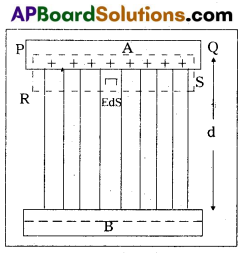
Consider a Gaussian surface PQRS. The flux through the ends PR and QS is zero, (∵ angle between E and ds is 90°). Electric flux through the surface PQ is zero, because inside the conductor charge is zero.
The only contribution of electric flux is due to the surface RS. Total electric flux through the entire Gaussian surface is
ΦE = \(\oint \mathrm{E} \cdot \mathrm{dS}=\oint \mathrm{EdS} \cos \theta\)
(∵ Angle between E and dS is zero, i.e., θ = 0)
ΦE = \(\oint \mathrm{E} \cdot \mathrm{dS}\) (∵ \(\oint \mathrm{dS}=\mathrm{A}\))
Let A be the area of each plate ΦE = E.A …………. (1)
Applying Gauss law ΦE = \(\frac{1}{\varepsilon_0}\) q ………… (2)
From eq’s (1) and (2), EA = \(\frac{\mathrm{q}}{\varepsilon_0}\)
E = \(\frac{\mathrm{q}}{\varepsilon_0 \mathrm{~A}}\)
The potential difference V between the plates can be written as
V = E.d = \(\frac{\mathrm{q}}{\varepsilon_0 \mathrm{~A}}\).d (∵ C = \(\frac{\mathrm{q}}{\mathrm{v}}\))
\(\frac{\mathrm{q}}{\mathrm{v}}\) = \(\frac{\varepsilon_0 \mathrm{~A}}{\mathrm{~d}}\)
∴ C = \(\frac{\varepsilon_0 \mathrm{~A}}{\mathrm{~d}}\)
Question 15.
State and explain Ampere’s Law.
Answer:
Ampere’s law : The line integral of the intensity of magnetic induction field around closed path is equal to p0 times the net current (i) enclosed by the path.
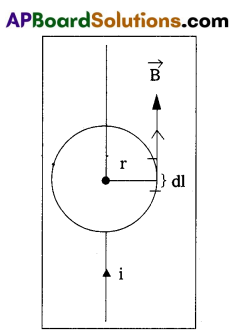
\(\oint \overrightarrow{\mathrm{B}} \cdot \overrightarrow{\mathrm{d} l}\) = µ0 i
Proof : Consider a long straight conductor carrying current i as shown in figure. Magnetic induction at a distance r from the conductor is given by
B = \(\frac{\mu_0 i}{2 \pi r}\) (From Biot – Savart’s law)
The value of B is same at all points on the circle.
\(\int \overrightarrow{\mathrm{B}} \cdot \overrightarrow{\mathrm{d} l}=\int \mathrm{BD} l \cos \theta\)
= \(\mathrm{B} \oint \mathrm{d} l\) = B × 2πr
(∵ θ = 0° Angle between \(\) and \(\) is zero)
\(\frac{\mu_0 i}{2 \pi r}\) = 2πr
\(\int \overrightarrow{\mathrm{B}} \cdot \overrightarrow{\mathrm{d} l}\) = µ0 i
This proves Ampere’s circuital laws.
Question 16.
Describe the ways in which Eddy currents are used to advantage. ,
Answer:
Eddy currents are used to advantage in
i) Magnetic breaking in trains : A strong magnetic field is applied across the metallic drum rotating with the axle of the electric train. Thus large eddy currents are produced in the metallic drum. These currents oppose the motion of the drum and hence the axle of the train which ultimately makes the train come to rest.
ii) Induction Motor : Eddy currents are used to rotate the short circuited rotor of an induction motor. Ceiling fans are also induction motors which run on single phase alternating current.
iii) Electromagnetic damping: Certain galvanometers have a fixed core made of non magnetic metallic material. When the coil oscillates, the eddy currents generated in the core oppose the motion and bring the coil to rest quickly.
iv) Induction furnace : Induction furnace can be used to produce high temperatures and can be utilised to prepare alloys, by melting the constituent metals. A high frequency alternating current is passed through a coil. The eddy currents generated in the metals produce high temperatures sufficient to melt it.
v) Analogue energy meters: Concept of eddy currents is used in energy meters to record the consumption of electricity. Aluminium disc used in these meters get induced due to varying magnetic field. It rotates due to eddy currents produced in it.
Question 17.
Describe Rutherford atom model. What are the drawbacks of this model?
Answer:
Rutherford atom model: The essential features of Rutherford’s nuclear model of the atom or planetary model of the atom are as follows:
- Every atom consists of tiny central core, called the atomic nucleus, in which the entire positive charge and almost entire mass of the atom are concentrated.
- The size of nucleus is of the order of 10-15m, which is very small as compared to the size of the atom which is of the order of 10-10m.
- The atomic nucleus is surrounded by certain number of electrons. As atom on the whole is electrically neutral, the total negative charge of electrons surrounding the nucleus is equal to total positive charge on the nucleus.
- These electrons revolve around the nucleus ip various circular orbits as do the planets around the sun. The centripetal force required by electron for revolution in provided by the electrostatic force of attraction between the electrons and the nucleus.
Draw backs : According to classical E.M. theory.
- The revolving electron loses energy continuously, it must spiral inwards and eventually fall into the nucleus. As matter is s table, we cannot expect the atoms to collapse.
- Since the frequency or radiation emitted is the same as the frequency of revolution, the atom should radiate a continuous spectrum, but what we observe is only a line spectrum.
Question 18.
Distinguish between half and full wave rectifiers.
Answer:
| Half wave rectifier | Full wave rectifier |
| 1. Single diode is used. | 1. Two diodes are used. |
| 2. Only half wave is rectified. | 2. Full wave is rectified. |
| 3. Rectifier efficiency η = \(\frac{0.406 R_L}{r_f+R_L}\) |
3. Rectifier efficiency 0.812RL η = \(\frac{0.812 R_L}{r_f+R_L}\) |
| 4. Efficiency of half wave rectifier is 40.6%. | 4. Efficiency, of full wave rectifier is 81.2%. |
| 5. Output is discontinuous and pulsative. | 5. Output is continuous and pulsative. |
Section – C (2 × 8 = 16)
Note :
- Answer any two of the following questions.
- Each question carries eight marks.
- All are Long Answer Type Questions.
Question 19.
What is Doppler Effect ? Obtain an expression for the apparent frequency of sound heard, when the source is in motion with respect to an observer at rest Mention its applications.
Answer:
Doppler effect: The apparent change in the frequency heard by the observer due to the relative motion between the observer and the source of sound is called doppler effect.
When a whistling railway engine approaches an observer standing on the platform, the frequency of sound appears to increase. When it moves away the frequency appear to decrease.
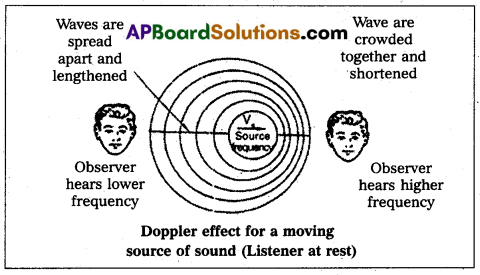
Expression for apparent frequency when source is in motion and listener at rest :
Let S = Source of sound
O = Listener .
Let ‘S’ be the source, moving with a velocity ‘υs‘ towards the stationary listener.
The distance travelled by the source in time period ‘T’ = υs.T.
Therefore the successive compressions and rarefactions are drawn closer to listener.
∴ Apparent wavelength λ = λ – υsT.
λ’ = λ – \(\frac{υ_s}{n}\) [n = \(\frac{1}{\mathrm{~T}}\)] = \(\frac{\lambda v-υ_s}{v}\) = \(\frac{υ-υ_s}{v}\) [∵ υ = vλ]
If “v” is apparent frequency heard by the listener. then “v” = \(\frac{v}{\lambda^{\prime}}\) where ‘υ’ is velocity of sound in air v = \(\frac{υ . v}{υ-υ_s}\)
Therefore the apparent frequency is greater than the actual frequency.
Note : If the source is away from the stationary listener then apparent frequency v = \(\frac{υ . v}{υ+υ_s}\), which is less than the actual frequency.
Limitation: Doppler effect is applicable when the velocities of the source and listener are much lessthan that of sound velocity.
Applications:
- Doppler effect is used to accurate navigation of air crafts.
- It is used to study satum rings.
- It is used to estimate the speed of automobiles.
![]()
Question 20.
State Kirchhoff s law for an electrical network. Using these laws, deduce the condition for balance in a Wheatstone Bridge.
Answer:
1) Kirchhoff s first law (Junction rule or KCL): The algebra sum of the currents at any junction is zero.
∴ Σ I = 0
(or)
The sum of the currents flowing towards a junction is equal to the sum of currents away from the function.
2) Kirchhoff s second law (Loop rule or KVL): The algebraic sum of potential around any closed loop is zero.
∴ Σ (IR) + Σ E = 0
Wheatstone bridge : Wheatstone’s bridge circuit consists of four resistances R1, R2, R3 and R4 are connected to form a closed path. A cell of emf e is connected between the point A and C and a galvanometer is connected between the points B and D as shown in fig. The current through the various branches are indicated in the figure. The current through the galvanometer is Ig and the resistance of the galvanometer is
Applying Kirchhoff’s first law
at the junction D, I1 – I3 I1 – Ig = 0 ………….. (1)
at the junction B, I2 + Ig I4 = 0 ………… (2)
⇒ Applying Kirchhoff s second law to the closed path ADB,
– I1R1 – IgG + I2R2 = 0
(or)
⇒ I1 R1 + IgG = I2R2
⇒ to the closed path DCBD
– I3R13 + I4R2 = IgG = 0
⇒ I3R3 – IgG = I4R4
⇒ When the galvanometer shows zero deflection the points D and B are at the same potential so Ig = 0.

Substituting this value in (1), (2), (3) and (4).
I1 = I3 – (5)
I2 = I4 – (6)
I1R1 = I2R2 – (7)
I3R3 = I4R4 – (8)
⇒ Dividing (7) by (8)
\(\frac{I_1 R_1}{I_3 R_3}=\frac{I_2 R_2}{I_4 R_4}\) ⇒ \(\frac{R_1}{R_3}=\frac{R_2}{R_1}\) [∵ I1 = I3 & I2 = I4]
∴ Wheatstone’s Bridge principle :
R4 = R3 × \(\frac{\mathbf{R}_2}{\mathrm{R}_1}\)
Problem:
Given three resistances are identical.
Hence R1 = R2 = R1 = x (say)
Total resistance in parallel, Rp = \(\)
If three identical resistances are connected in parallel, then
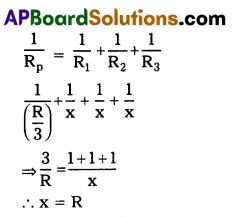
Quetsion 21.
Explain the principle and working of a nuclear reactor with the help of a labelled diagram.
Answer:
Principle : A nuclear reactor works on the principle of achieving controlled chain reaction in natural Uranium 238U enriched with 235U, consequently generating large amounts of heat.
A nuclear reactor consists of
1) Fuel
2) Moderator
3) Control rods
4) Radiation shielding
5) Coolant.
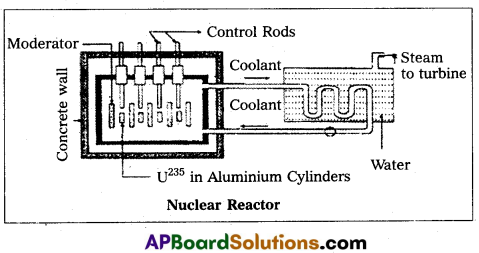
1) Fuel and clad: In reactor the nuclear fuel is fabricated in the form of thin and long cylindrical rods. These group of rods treated as a fuel assembly. These rods are surrounded by coolant, which is used to transfer of heat produced in them. A part of the nuclear reactor which use to store the nuclear fuel is called the core of the reactor which use to store the nuclear fuel is called the core of the reactor. Natural uranium, enriched uranium, plutonium and uranium – 233 are used as nuclear fuels.
2) Moderator: The average energy of neutrons released in fission process is 2 MeV They are used to slow down the velocity of neutrons. Heavy water or graphite are used as moderating materials in reactor.
3) Control Rods: These are used to control the fission rate in reactor by absorbing the neutrons. Cadmium and boron are used as controlling the neutrons, in the form of rods.
4) Shielding: During fission reaction beta and gamma rays are emitted in addition to neutrons. Suitable shielding such as steel, lead, concrete etc., are provided around the reactor to absorb and reduce the intensity of radiations to such low levels that do not harm the operating personnel.
5) Coolant: The heat generated in fuel elements is removed by using a suitably coolant to flow around them. The coolants used are water at high pressures, molten sodium etc.
Working : Uranium fuel rods are placed in the aluminium cylinders. The graphite moderator is placed in between the fuel cylinders. To control the number of neutrons, a number of control rods of cadmium or beryllium or boron are placed in the holes of graphite block. When a few 235U nuclei undergo fission fast neutrons are liberated. These neutrons pass through the surrounding graphite moderator and loose their energy to become thermal neutrons. These thermal neutrons are captured by 235U . The heat generated here is used for heating suitable coolants which in turn heat water and produce steam. This steam is made to rotate steam turbine and there by drive a generator of production for electric power.